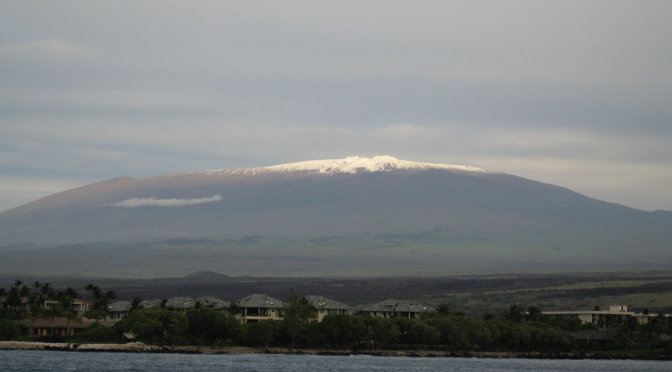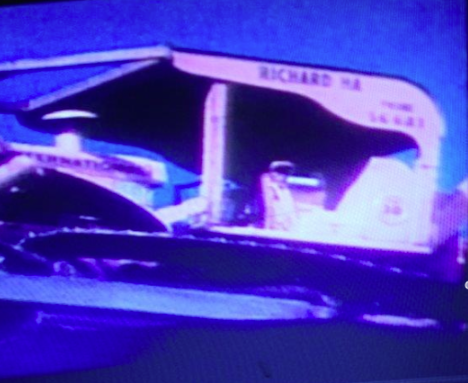Peter Apo, Office of Hawaiian Affairs trustee, recently talked about something that really struck me: He said the claim that the whole of Mauna Kea is sacred cannot be validated.
One thing that had been puzzling him, he says, is that in previous cultural clashes here in Hawai‘i, scholars always participated – but this time they were silent.
“With the TMT, there was this tremendous silence,” he said. “No one was speaking out.” So, he said, he did his own research, consulting with 12 or 13 leading scholars on the topic.
Cultural claims, he said, are validated three ways: by archaeology, oral tradition (“such as the Kumulipo”), or through present-day scholars.
“And the litmus test is there has to be a historical basis for that belief system or practice,” he said. “You have to show it was exercised in the past. And you have to have a pattern of frequency. None of that was present, at least in my foray in the research.”
“Long story short,” he says, “the claim [of the entire mountain being sacred] could not be validated.”
He write about this in more detail at Let There Be Light on the TMT at Civil Beat:
This research has led me to some conclusions. First, there are indeed places on Mauna Kea that are sacred. These are places where Hawaiians have continuously participated in traditional and customary practices; so there are unquestionably specific geo-cultural sites on Mauna Kea that are protected, and the practices that are associated with these sites meet all the defining criteria of being traditional and customary.
But the extension of sacredness to the entire mountain and the air column above it gives rise to questions about how much cultural validation there is for the idea that this pre-empts any and all other uses of the mountain.
I found no documentation indicating that Mauna Kea, as a whole, is sacred. I could not find any reference to any blanket of sacredness over the entire mountain and the air column in any of the usual sources of validation — not even in the Kumulipo Hawaiian creation-origin chant, or in the writings of Native Hawaiian historians of the 19th century like Samuel Kamakau, David Malo, John Papa ‘I‘i and Kepelino.
Beyond the blanket-of-sacredness claim, there is nothing else on record to suggest any validated sacred places would be disturbed by the construction or operation of the TMT.
Validated sacred places include the peaks of Pu‘u o Kūkahau‘ula, Pu‘u Poli‘ahu and Pu‘u Lilinoe, Lake Waiau, and various heiau (temples), ‘ahu (altars), ana (caves), lua kā ko‘i (quarries), and ilina (burials).
In fact, I believe the decision about the TMT’s location was made to ensure that no sacred site was violated, nor access to any sacred site impeded. The telescope was also sited below the summit to minimize its visual obtrusiveness. Read the rest
This rings very true to me.
My Pop helped to bulldoze the road to the summit of Mauna Kea back in about 1964, and when I think back to that time, none of my Hawaiian relatives at Maku‘u ever said one word against it. No one ever even hinted it was against religious and cultural practices. I don’t remember our relatives ever telling us that the mountain was forbidden territory.
Pop was proud of what he was doing, and my brother Robert used to fuel up and service his bulldozer.
See the name at the top of the TD 30? That’s my dad. (I’m a junior.) This picture of my Pop operating his bulldozer on the summit of Mauna Kea is from a PBS clip that you can see here.
There was no mention of anyone up on the mountain protesting when Pop was building the road, because there wasn’t anybody protesting. There was never any feeling he was doing anything against the culture. There was no discussion about it, period.
Peter Apo said something that makes so much sense to me:
“The TMT presents probably the greatest opportunity – the greatest cultural opportunity, religious opportunity – that we will ever have to do the one thing that is at the center of every cultural group. That is, search for the ancestors. Our story of creation begins with the night of Pō, with the darkness. I’m assuming that at some point in time, with projects like the TMT, we will actually be able to go back and find the Night of Pō. I cannot think of anything more significant than that.”
I agree, and I don’t think it was a bad thing that Pop helped build that road. We humans are always trying to climb up to the top of a mountain to see what’s on the other side. I’m curious to see back in time.
My concern is that we are shutting off the opportunity to possibly learn the answer to the greatest question mankind ever asked: “I wonder what’s on the other side?”



No protesters when the other observatories were built either…I think these protesters are totally wrong….
Amen.
This is a positive article! I am not certain but one of our treasured Hawaiian Kings actually was the praised for bringing in the first scientist to study,etc.
Growing up in the 1950’s here…..on the Big Island no one made a fuss. No one.
I just don’t understand why an open discussion between the scientist & the modern day protesters should be happening right now.
Richard,
A great article , I suggest that you send this to WHT and the Honolulu Examiner plus the NYT and the WSJ. A vocal minority have intimidated the local politicians and the governor who appears to be incapable of many a firm stand on any issue. The High Speed Ferry and the TMT both have been caught up in ” permit ” issues , the former wrote off $330 million and TMT had spent at least $170 million. It is hardly surprising that Hawaii has such a poor record in attracting business investment and yet the headlines question why so many educated young people leave for prospects on the mainland or overseas.
Clive B Davies, I don’t think you’re saying that the ferry and the TMT are equivalent, but I think the two are easily conflated. So far, no one has been able to show any realistic environmental impacts of the TMT — but for the ferry, there are plenty, mainly invasive species.
Here on the Big Island we have the fire ants, the coqui, the ohia wilt, just to name three. A bit of thought and a good dose of observable reality will lead to a conclusion that if the ferry had been in operation for, say, the last 10 years, that all of the islands it serviced would have these problems. Would vehicles be sterilized? Plants? Wood? Of course not.
I think that the ferry failure was a good thing, and that a TMT failure would be a wretchedly bad thing.
I was one of those young people who left Hilo (in 1960) because all the opportunities were on the mainland. I’m back here now, hoping that the same won’t be true for the young people in the future. If the TMT isn’t built, I think we’ll be back to those bad old days.
This article does not address the prolonged illegal occupation that is in effect today. It does not give any historical information leading up to the first telescopes. that. I suggest a more comprehensive, fact-based article. Less about your papa and the lack of outcry, more about the historical facts rather than claims. American federal laws in place today are not what they were in the fifties. To say that the first telescopes construction is comparable to the TMT or allude to it, would be a fallacy.
https://m.youtube.com/watch?feature=youtu.be&v=MO6zyAoG-QM
Who owns Hawaii????
Remembering watching a video
Anake Kanakaole climbing Mauna Kea
Asking forgiveness from the ancestors
For What they doing to Mauna Kea.
To me I think all Hawaii is sacred.
How many generations does the Kumulipo go back.
Where do you think they were buried????
Ku Kane Kanaloa Lono were people.
Kilikina has much to share.
But if you don’t want to I’ll understand.
123 years is a long time.
Blessings 2u Mr Ha
Kapu Aloha from MK
The real question is IS PETER APO REALLY HAWAIIAN?
Ha Ha Ha. The answer to that is he is a Paid-off Hawaiian. And the scholars have been testifying against since telescope number one, Peter wasn’t there, so in his universe, it didn’t happen. The next question is, will Ha hire back those he fired when he gets his pakalolo farm?
When I was approached to participate in the medical marijuana project, I told them that my workers would have to get the first chances to get work at the new facility. I also required that security cameras be installed to monitor traffic going up and down the road outside the facility for my neighbors security. We have to shut the farm down because of the banana bunchy top virus (BBTV) moving down the coast. We already found it on the farm. I had to move our banana farm from Keaau to Pepeekeo because of BBTV.
Every ancient culture has gone to the mountaintops to observe and contemplate the heavens. Surely, Polynesians, the most accomplished of ancient mariners, would have. Opposition to the TMT, a project conceived and designed mostly by haoles, sounds like sour grapes to me. To their credit, Hawaiians have embraced or adapted to foreign influences (music, food, etc.) better than many other indigenous cultures without losing their cultural identity. Why not now? Astronomers desperately desire to avoid pollution of their sites. Our understanding of the universe has increased dramatically in the last 100 years, but learning more has become very expensive. We can only continue if people all over the world cooperate.
Yes, I’m a haole. 300 years ago, we burned witches. We got over it.
As a Kapuna, I have lived a long life and remember well what transpired over the last 80 years. Hawaii voted for statehood and that it became part of the US, ends the long history of occupation illegally. As with any country, kingdom or area that gets conquered, territory gets assimilated and becomes part of the conquering nation. France was once Gaul, Iraq was Mesopotamia, and so on. Boundaries and territories change and the young people who wish it weren’t so, are out of touch.
Mauna Kea was never considered sacred in the totality according to all Hawaiian history. The newly found religious concepts of the olelo school graduates are opining to have revisionist history. This is not the true history. As we all like to think that Pele occupies Kilauea and Poliahu sits on top of Mauna Kea, this is ancient folklore. We all know that Pele doesn’t really exist but it is comforting to think that we have alternate concepts to reality.
As Hawaiians naviagted the pacific ocean and found the islands, we are all aware that this was done by celestial navigation and that alone shows that the newly indigenous Hawaiian people valued the concepts of astronomy and science. Anyone who tells you different is doing a disservice to all Hawaiians!